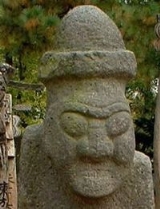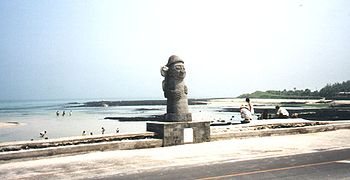
Dol hareubang
Encyclopedia
Dol hareubangs, also called tol harubangs, hareubangs, harubangs, are large mushroom-like statues found on Jeju Island off the southern tip of Korea
. They are considered to be gods offering both protection and fertility and were placed outside of gates for protection against demon
s travelling between realities.
(volcanic rock
) and range in size up to 3 metres high. The statues' faces feature grinning expressions and bulging eyes without pupils, a long, broad nose, and slight smile and their hands rest on their bellies, one slightly above the other. In sets of two, one will have a higher left hand and the other a higher right hand. The hat is commonly referred to as phallic or mushroom-like.
word hareubang (하르방) meaning "grandfather" or "senior" (harabeoji [할아버지] in Standard Korean) and was coined in the mid-20th century. Other earlier names for the statues include beoksumeori, museongmok, useongmok. Beoksumeori, meaning shaman
head, is used in the former area of Jeongui Hyeon
(county), museongmok in Daejeong Hyeon and Jeongui Hyeon, and useongmok only in Jeju Hyeon. Historically, the Tamna
Chronicles called them ongjungseok (옹중석/翁仲石) but this usage is unknown today.
 There are three main theories as to the origin of dol hareubangs; either that they were introduced by visitors from the sea, that they are a counterpart to the jangseung
There are three main theories as to the origin of dol hareubangs; either that they were introduced by visitors from the sea, that they are a counterpart to the jangseung
s (totem poles) of mainland Korea, or that they spread with shamanic mushroom culture. Jangseungs are also called beoksu in southern Korea and this similarity with the name beoksumeori lends credence to the second and third theories.
Halla San has been named in Chinese literature as one of the "Sam Shin San" (삼신산/ 三神山), or one of the Three Spirit Mountains. Each of these mountains are considered gateways to the spirit world, and have the Amanita muscaria
growing in abundance. This mushroom is well known by the Siberians and is a possible origin for the Stone Grandfather.
This theory lends that powerful shamans descending from the north established a magic mushroom cult on the island in which stone grandfathers were set at the sides of thresholds to prevent the entry of unwanted spirits.
The mushroom and its related imagery has had great importance in Korea, visible in ancient crowns, funeral urns, the Ship Jang Saeng Do (십장생도). The Dol Harubang are a form of political propaganda, representations of the sacred powers of the mushroom, its associated deity, and attesting to the power of the Shamans.
Dol hareubangs produced from 1763-1765 once stood outside the eastern, western, and southern gates of the Jeju City
fortress as guardian deities.
 Dolhareubangs have become the symbol of Jeju Island and replicas of various sizes are sold as tourist souvenirs. The statues are sometimes sold as sources of fertility and small replicas are sometimes given to women with fertility problems. The origin of this may have more to do with Jeju Do's present day status as a 'honeymoon island' than tradition.
Dolhareubangs have become the symbol of Jeju Island and replicas of various sizes are sold as tourist souvenirs. The statues are sometimes sold as sources of fertility and small replicas are sometimes given to women with fertility problems. The origin of this may have more to do with Jeju Do's present day status as a 'honeymoon island' than tradition.
Korea
Korea ) is an East Asian geographic region that is currently divided into two separate sovereign states — North Korea and South Korea. Located on the Korean Peninsula, Korea is bordered by the People's Republic of China to the northwest, Russia to the northeast, and is separated from Japan to the...
. They are considered to be gods offering both protection and fertility and were placed outside of gates for protection against demon
Demon
call - 1347 531 7769 for more infoIn Ancient Near Eastern religions as well as in the Abrahamic traditions, including ancient and medieval Christian demonology, a demon is considered an "unclean spirit" which may cause demonic possession, to be addressed with an act of exorcism...
s travelling between realities.
Description
The dol hareubangs are carved from porous basaltBasalt
Basalt is a common extrusive volcanic rock. It is usually grey to black and fine-grained due to rapid cooling of lava at the surface of a planet. It may be porphyritic containing larger crystals in a fine matrix, or vesicular, or frothy scoria. Unweathered basalt is black or grey...
(volcanic rock
Volcanic rock
Volcanic rock is a rock formed from magma erupted from a volcano. In other words, it is an igneous rock of volcanic origin...
) and range in size up to 3 metres high. The statues' faces feature grinning expressions and bulging eyes without pupils, a long, broad nose, and slight smile and their hands rest on their bellies, one slightly above the other. In sets of two, one will have a higher left hand and the other a higher right hand. The hat is commonly referred to as phallic or mushroom-like.
Etymology
The name dol hareubang derives from the Korean word for "stone" (dol 돌) plus the Jeju dialectJeju dialect
Jeju dialect or Jeju language is the dialect used on the island of Jeju in Korea, with the exception of Chuja in the former Bukjeju County area of Jeju City. It differs greatly from the dialects of the mainland, and preserves many archaic words which have since been lost in other Korean dialects...
word hareubang (하르방) meaning "grandfather" or "senior" (harabeoji [할아버지] in Standard Korean) and was coined in the mid-20th century. Other earlier names for the statues include beoksumeori, museongmok, useongmok. Beoksumeori, meaning shaman
Shamanism
Shamanism is an anthropological term referencing a range of beliefs and practices regarding communication with the spiritual world. To quote Eliade: "A first definition of this complex phenomenon, and perhaps the least hazardous, will be: shamanism = technique of ecstasy." Shamanism encompasses the...
head, is used in the former area of Jeongui Hyeon
Hyeon
The hyeon were administrative subdivisions of Korea during the Silla, Goryeo, and Joseon periods. They were typically slightly smaller than today's si and gun . They were abolished in the Gabo Reform of 1895.During the Goryeo period, there were about 335 Hyeon; during the Joseon period, 164....
(county), museongmok in Daejeong Hyeon and Jeongui Hyeon, and useongmok only in Jeju Hyeon. Historically, the Tamna
Tamna
The kingdom of Tamna or Tamna guk ruled Jeju Island from ancient times until it was absorbed by the Korean Joseon Dynasty in 1404. This kingdom is also sometimes known as Tangna , Seomna , and Tammora . All of these names mean "island country."There is no historical record of the founding or early...
Chronicles called them ongjungseok (옹중석/翁仲石) but this usage is unknown today.
History

Jangseung
A jangseung or village guardian is a Korean totem pole usually made of wood. Jangseungs were traditionally placed at the edges of villages to mark for village boundaries and frighten away demons...
s (totem poles) of mainland Korea, or that they spread with shamanic mushroom culture. Jangseungs are also called beoksu in southern Korea and this similarity with the name beoksumeori lends credence to the second and third theories.
Halla San has been named in Chinese literature as one of the "Sam Shin San" (삼신산/ 三神山), or one of the Three Spirit Mountains. Each of these mountains are considered gateways to the spirit world, and have the Amanita muscaria
Amanita muscaria
Amanita muscaria, commonly known as the fly agaric or fly amanita , is a poisonous and psychoactive basidiomycete fungus, one of many in the genus Amanita...
growing in abundance. This mushroom is well known by the Siberians and is a possible origin for the Stone Grandfather.
This theory lends that powerful shamans descending from the north established a magic mushroom cult on the island in which stone grandfathers were set at the sides of thresholds to prevent the entry of unwanted spirits.
The mushroom and its related imagery has had great importance in Korea, visible in ancient crowns, funeral urns, the Ship Jang Saeng Do (십장생도). The Dol Harubang are a form of political propaganda, representations of the sacred powers of the mushroom, its associated deity, and attesting to the power of the Shamans.
Dol hareubangs produced from 1763-1765 once stood outside the eastern, western, and southern gates of the Jeju City
Jeju City
Jeju is the capital of Jeju province in South Korea and the largest city on the island of Jeju. Its geographical location is . The city is served by Jeju International Airport ....
fortress as guardian deities.
Dolhareubangs today

See also
- DendroglyphDendroglyphIn the Chatham Islands the indigenous Moriori people practiced the art of momori rakau as a ritual possibly associated with death or remembrance. Many scholars over the years have tried to penetrate the reasons behind these incisions into the trunks of the kopi trees and none have come up with a...
- JangseungJangseungA jangseung or village guardian is a Korean totem pole usually made of wood. Jangseungs were traditionally placed at the edges of villages to mark for village boundaries and frighten away demons...
- Korean shamanismKorean shamanismKorean shamanism, today known as Muism or sometimes Sinism , encompasses a variety of indigenous religious beliefs and practices of the Korean people and the Korean area...
- LingamLingamThe Lingam is a representation of the Hindu deity Shiva used for worship in temples....
- Religion in KoreaReligion in KoreaReligion in Korea encompasses a number of different traditions. Traditional Buddhism, Mugyo with a background of Korean Confucianism and later Christianity all play a role in Korea's religious tradition...
External links
- Jeju's symbol: Dolhareubang at Jeju Special Self-governing Province website

